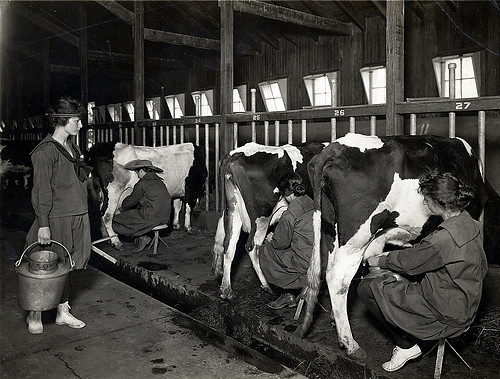The Vassar Farm
July 1, 2010 by admin
The following post was adopted from the Vassar Farm and Ecological Preserve website
In 1895, the first 200 acres of the Vassar Farm were purchased from Vassar Brothers Hospital to solve a problem. Up until then, Vassar had been pumping its sewage into the Casperkill creek but another plan was needed. About the same time, Ellen Swallow Richards, a Vassar graduate of the class of 1870 and an expert in water chemistry and sanitation, suggested that the college should create a settling field and filter beds to handle the campus waste. This was considered an innovative approach to sewage disposal at the time, and nutrients from the system were said to dramatically increase corn yield. Remnants of the filter beds are still visible today in the northwest corner of the Ecological Preserve.
In 1911, Augustus and May Elton Davies deeded the southern 300 acres of the current preserve to the college as a gift. These two large parcels were then consolidated with some smaller pieces of land to become a single tract, and Vassar’s farming operation was relocated there. According to the 1918-19 Vassar College Catalogue, the farm included “a model dairy and poultry farm, greenhouses, stables, storage barns and farm houses….[It] produces vegetables for the college table, and grain and fodder for the cattle and poultry. The dairy supplies milk and cream for the college from a tested herd of Holstein cattle.”
In World War I and again in World War II, extra help during the summer months was in short supply, so Vassar girls worked as farmhands. The first 12 girls who worked on the farm in the summer of 1917 as part of this patriotic experiment were called “Farmerettes.” They put in 45-hour weeks at 17 ½ cents an hour doing “every kind of work that the men tried, with the exception of cleaning the stables.” They chopped wood, milked cows, ploughed fields, and hoed the rows. This was such a novel accomplishment that the Vassar Farm Unit was invited to present a “live exhibit” at the Eastern States Exposition, a ten-state agricultural fair, and five girls were excused from class for ten days to demonstrate their farming skills at the fair.
By the mid 1950s, the farm was no longer a cost-efficient means of providing food for the college, and the farming operation was shut down. A proposal by the Town of Poughkeepsie to use the Farm as a town dumpsite was rejected in favor of using part of the Farm as an educational preserve. In 1973, a group of faculty led by Margaret Wright of the Biology Department drafted a proposal for a center of ecological study on the Vassar Farm. In 1976, the college adopted a mixed-use plan that designated 275 acres as an ecological preserve for conservation and research. In 1978, the first field laboratory—a modified mobile home—was installed and the beginnings of a trail system were established. Today, 416 acres are actively managed as a preserve.
Read more about the history of the farm and preserve at the Vassar College Encyclopedia
The Farm Today:
The Vassar College community and Poughkeepsie area residents now utilize the 527 acre farm and ecological preserve in a variety of ways.
The Ecological Preserve is an invaluable resource for Vassar scientists. Vassar faculty and students conduct ecological research in the fields, forests, and in the Priscilla Bullitt Collins Field Station. The field station was built in 1995 on the ecological preserve and is used to study natural history, ecology, botany, and earth science. The Farm is a great location to study the Casperkill, as it is one of only places where the creek can meander freely across a forested floodplain—far from sources of garbage and chemical inputs.
Check out this youtube video about student researchers studying the Casperkill last summer
The Exploring Science at Vassar Farm program brings local elementary school children to the field station for hands-on lessons about nature and science. It also gives Vassar students who are interested in science education hands-on experience teaching second- and third-graders. Since its development in 1983, 35,000 children have participated in the program.
Several Vassar College and high school athletic teams utilize the fields on the farm and the trails on the preserve. Among others, the Vassar cross-country and rugby teams use the farm for both practice and competition.
The Community Gardens are available to community members on a first-come, first-served basis for a nominal fee. There are currently 120 plots available. Gardeners are required to follow three simple rules: garden organically, bring your own hose (but unhook it when you leave), and build your own fence.
Vassar Farm and Ecological Preserve also hosts other organizations, including:
The Poughkeepsie Farm Project, a member-supported organic farm, leases ten acres from Vassar College and grows vegetables for 300 members, the Poughkeepsie Farmers’ Market, and for local soup kitchens and shelters.
The Ralph Waterman Bird Club of Dutchess County, a group of about 400 members is dedicated to the observation, study, and conservation of birds and other wildlife. This club offers field trips throughout Dutchess County and regularly visits the preserve.
Greenway Environmental Services produces compost for farms, urban gardens, and municipalities in the Hudson Valley.
For further information about the Farm please check out:
– Vassar Farm Oral History Interviews 2006
– 1982 article by Professor Robert Suter, “Idyll thoughts and prescriptions from a farm ecologist.”

